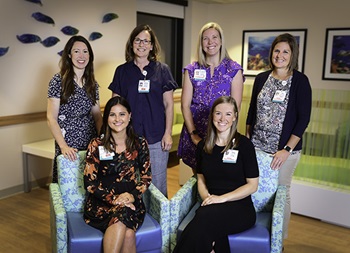In this section
MACC Fund Center for Cancer and Blood Disorders
- Programs and services
- Aplastic anemia
- Blood and Marrow Transplant and Cellular Therapy Program
- Cancer Predisposition Clinic
- COMPASS Clinic
- Fertility navigation program
- Hematology program
- Integrative medicine program
- KIDDs Program
- Next Steps survivorship program
- Oncology program
- Psychosocial services
- Sickle Cell Disease
- Thalassemia program
- Conditions
- Clinical trials
- Patient stories
- Locations
- Our specialists
- For medical professionals
- Contact us
- Diet and nutritional care
- Our philanthropic partners
- Get a second opinion
- Patient family information
Fertility navigation program
The MACC Fund Center’s Fertility Navigation Program supports people with cancer and blood disorders who may be at risk for future problems with fertility (the ability to produce a baby). Our care team includes Co-Directors Dr. Kerri Becktell (Oncology) and Dr. Rachel Phelan (Bone Marrow Transplant), Fertility Nurse Navigator, Katy Tomlinson, Nurse Practitioners Katie Robbins and Deb Schmidt, and Survivorship Nurse Clinician, Julie Nichols.

We meet with patients and families who want to learn more about their fertility risk and fertility preservation options (collecting and saving eggs or sperm outside of the body, to use in the future to try to have a baby). Discussion can happen from the time of a new diagnosis, all the way through to the end of treatment and after treatment is complete. Some people choose to have a fertility preservation procedure and some people do not. Our goal is to make sure all patients and families understand their fertility risk and the options that are available for fertility preservation. This is how patients and families can make the best decisions for themselves.
We look at the treatment plan to understand the level of risk.
These things can create fertility risk:
- Chemotherapy
- Immunotherapy
- Radiation
- Surgery
- Bone marrow transplant
- CAR-T therapy
We also look at specifics for each patient:
- Age
- Stage of puberty
- Type of cancer or blood disorder
With this information, we educate and counsel on fertility risk and preservation options.
Fertility preservation options we offer:
- Sperm banking
- Testicular tissue cryopreservation
- Egg banking
- Ovarian tissue cryopreservation (partnering with Anne and Robert H. Lurie Children’s Hospital in Chicago, IL)
- Other options may be available based on specific patient needs
Along with fertility, we also discuss hormones and how treatment or illness may affect the body’s ability to make certain hormones. The MACC Fund Center fertility team works with providers who specialize in fertility, hormones, growth and development. The team may refer you to a specialist in one of these areas:
- Adolescent medicine
- Endocrinology
- General surgery
- Psychology
- Reproductive endocrinology
- Urology
The specialists will help you learn more about your options. They will take the best care possible of your fertility and hormone health. The fertility navigation team is here to help guide you through the process.
Fertility preservation for saving eggs
Online fertility resources
Children's Oncology Group
Patient and family education (“Health Links”) for male and female health issues after treatment for childhood cancers.
Froedtert Hospital Reproductive Medicine
Fertility preservation information from Froedtert and the Medical College of Wisconsin's Fertility and Reproductive Medicine team
Livestrong
Learn about fertility risks, options, and discount programs for fertility preservation from the Livestrong Foundation
Oncofertility Consortium
Connect with community and online fertility resources through this international group designed to explore the reproductive future of cancer survivors
Save My Fertility
Online fertility preservation toolkit for patients and their providers
Verna's Purse
Financial Assistance Program for fertility preservation in cancer survivors
Contact us
If you need more information, call our Fertility Navigator at (414) 266-3712.
